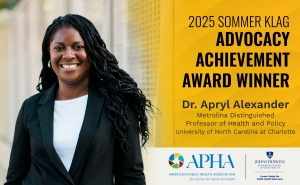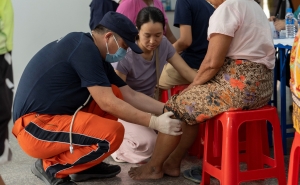New Report on Enforcement of Gun Laws in Baltimore Finds More Focused Approached Could Reduce Violence, Improve Community Relationships with City Police
Report finds communities most impacted by gun violence want greater focus on individuals at high risk to engage in gun violence and stronger accountability measures to reduce illegal searches
A new report from the Johns Hopkins Center for Gun Policy and Research at the Johns Hopkins Bloomberg School of Public Health finds that broad “stop-and-search” practices used for many years by Baltimore police to look for illegally possessed guns have minimal, if any, impact on gun violence. These practices also result in mental and physical harm to those who are unjustifiably searched and serve to undermine community trust in police.
The researchers also found that residents of communities most impacted by gun violence in Baltimore want more focused and accountable law enforcement to reduce gun violence.
The report, Reducing Violence and Building Trust: Data to Guide Enforcement of Gun Laws in Baltimore, was written prior to the recent killing of George Floyd by Minneapolis, Minnesota, police and the resulting protests opposing law enforcement violence.
The researchers conducted 200 household surveys and four focus group discussions in 2018 in parts of West and East Baltimore that experience high levels of gun violence. The report also draws on analyses of law enforcement data in Baltimore, law enforcement practices in other cities, a 2018 review of proactive policing by the National Academies of Science, Engineering and Medicine, and a survey of practices from other law enforcement agencies.
Among the report’s findings:
- High level of concern about illegal gun carrying. Seventy-seven percent of surveyed residents were concerned about people illegally carrying guns.
- High level of concern about stop-and-search practices. Half of respondents feel that police make too many stops and searches. Nearly two out of three respondents thought police did not stop those who are responsible for most of the violence.
- Support for more transparency and oversight of enforcement of gun laws. Ninety percent of residents wanted law enforcement leaders to track the outcomes from arrests for illegal gun possession—i.e., how many cases were dismissed due to illegal searches or evidence of officers planting weapons and how many resulted in guilty pleas or convictions. Eighty-eight percent wanted prosecutors to review officers’ body-worn camera footage, as there was widespread doubt about officers’ testimony about weapon-related arrests.
- Support for greater accountability. Fifty-four percent thought making data public on gun charges dismissed due to illegal searches and community-member participation on police oversight would increase trust in police.
The report also found that highly focused enforcement of gun laws consistently led to fewer shootings in Baltimore and in other cities where research on focused gun carrying suppression has been studied. The same was true for focused-deterrence initiatives which couple the prospects of incarceration for shootings with social supports to support those at highest risk for committing violence.
The authors also make a series of recommendations for approaches to enforcing gun laws in Baltimore that are focused, effective, constitutional, and respectful of community concerns.
“Communities most impacted by gun violence want greater focus on violent offenders with guns and stronger accountability measures to reduce illegal searches,” says project leader Daniel Webster, ScD, MPH, Bloomberg Professor of American Health in the Department of Health Policy and Management and director of the Center for Gun Policy and Research at the Bloomberg School. “As it turns out, what residents of communities hardest hit by gun violence in Baltimore want are policies that research has shown to be effective in curbing gun violence.”
“Reducing Violence and Building Trust” was motivated by the dual crises of Baltimore’s record-setting homicide rates and community lack of trust in police. Baltimore’s homicide rate in 2019 was the highest for any U.S. city of more than 500,000 people, at 58 per 100,000 residents. Almost 90 percent of the city’s homicides are committed with guns. In recent years, the Baltimore Police Department has been marred by controversy and scandal, including 15 members of the Baltimore Police Department’s Gun Trace Task Force being charged and found guilty of committing serious crimes. Since 2017, the Department has been subject to a federal consent decree mandating reforms in the wake of a U.S. Department of Justice investigation detailing a pervasive pattern and practice of unconstitutional policing.
Based on these findings, the report’s authors recommend that Baltimore police adopt a more focused strategy to enforce gun laws that is driven by intelligence and data from criminal investigations; targets high-risk individuals; is led by small teams of officers trained in constitutional policing and working out of police districts; and is conducted with close supervision and oversight to promote trust in the police in local communities.
Among the report’s recommendations for Baltimore:
- Enforcement of gun laws should be highly focused and led by experienced officers working out of police districts who are closely supervised and trained in constitutional policing.
- The Office of the State’s Attorney should collect and share data with the Baltimore Police Department on all gun charges, prosecution outcomes, and reasons for case dismissals including illegal searches and improper evidence handling.
- Police supervisors should use these data to monitor gun arrest outcomes for each officer, including cases dismissed due to an illegal search, and use the data to promote practices that are lawful and promote community trust in police.
- Baltimore should implement a focused-deterrence strategy, or Group Violence Intervention, which involves identification of individuals and groups that are driving a large share of shootings. This strategy would require coordination among police and prosecutors to collect evidence and warn identified individuals about harsh sanctions if they do not stop the violence. The deterrence strategy should also include offering assistance to high-risk individuals including comprehensive social services and support from respected members of the community to stop the violence.
“What we’re calling for is, in essence, stronger quality control processes for enforcement of gun laws,” says Cassandra Crifasi, PhD, MPH, deputy director at the Center for Gun Policy and Research at the Bloomberg School and one of the report’s co-authors. “Enforcement of gun laws in Baltimore should be done in a focused, evidence-based way to deter gun violence, bring to justice those who commit gun violence, and build trust in police in affected communities.”
The authors contend that reforms that increase police accountability and residents’ trust in the police could also be helpful in addressing another challenge that is contributing to persistently high homicide rates in Baltimore—a growing number of unsolved homicides that can fuel retaliatory violence.
The researchers hope that their recommendations will influence gun law enforcement policy not only in Baltimore but in other American cities. “These strategies to reduce violence and build trust could apply to cities across the country that have high rates of gun violence and are seeking to enhance police accountability. We hope this report and its recommendations will be translatable across communities,” Webster says.
“Reducing Violence and Building Trust: Data to Guide Enforcement of Gun Laws in Baltimore” was written by Daniel Webster, Cassandra Crifasi, Rebecca Williams, Marisa Doll Booty, and Shani Buggs.
The project was funded by the Bloomberg American Health Initiative of the Johns Hopkins Bloomberg School of Public Health, the Annie E. Casey Foundation, and the Abell Foundation.
# # #
Media contacts for the Johns Hopkins Bloomberg School of Public Health: Caitlin Hoffman at choffman@jhu.edu and Barbara Benham at bbenham1@jhu.edu.





